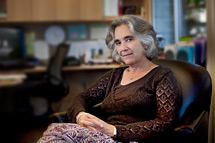

Friday - September 10, 2010
SLAC Today is
available online at:
http://today.slac.stanford.edu
In this issue:
From the Director: Tragedy in San Bruno
SLAC to Participate in DOE Cooperative Protection Program
Welcome, New SLACers!
Word of the Week: Phonon
 |
 |
|
Friday - September 10, 2010 |
From the Director: Tragedy in San Bruno (Photo by Brad Plummer.)
Like many of you, I spent Thursday night glued to the television, horrified by the terrible events unfolding in San Bruno. I know that some of you are either directly affected or have family and friends who are affected. This is our neighborhood, and our friends and neighbors have lost their homes, are among the hundreds evacuated, or perhaps are among those who are injured and being treated at regional hospitals. It is heartbreaking to see the people who left their homes with no time to prepare and who don’t know whether their homes have survived or not, who don’t know if their friends and neighbors are OK. Calls for help for those affected will go out in the next days. Already responders are asking for people to donate blood. Other help will be needed. I encourage you all to help and support those who are affected by this tragedy. For information about how you can help,
see the final paragraphs of: "American Red Cross Bay Area Chapter Assists Victims of the San Bruno Fire." SLAC to Participate in DOE Cooperative Protection ProgramSince 2001, the Department of Energy has been using a cyber monitoring tool called the Cooperative Protection Program. The CPP includes sensors deployed at the network boundaries of most DOE sites. The sensors collect data about the network traffic at the sites’ Internet boundaries and allow DOE cyber analysts a broad view of network traffic for threat trending, incident analysis and network forensics. A recent upgrade will enable CPP activation at SLAC in mid-September. Participation in the program will allow DOE cyber analysts to incorporate data from SLAC and leverage expertise of the SLAC cyber security team in confronting shared network-based threats, usually emanating from foreign sources. In general, the CPP sensors forward summary data but not content of all cyber traffic entering or leaving the DOE network at SLAC. In addition to the summary data, some data critical to modern cyber incident analysis are also captured, including domain or DNS queries, and certain fields from http (Web) requests. Read more... Welcome, New SLACers!SLAC welcomed 25 new staff members at New Employee Orientation, which took place on September 2. Front Row (left to right): Gina Castillo Bagley; Elsie N. Philips; Shanjie Xiao; Zheqiao Geng; Phillip A. Williams, Hiwot Kassaye Betre; Erica Alvarez; Karen Horovitz; Rujjira Kong; Frank Abild-Pedersen; Mayank Malik Back Row (left to right): Robert Coy; Andrew Gayles; Michael Earley, Andrew Hammond; Thomas James Senander; Rafael Robledo; Kyle Connally; Ruben Curiel; Jerry Pierre; John Kipp; Steve Lewis; Randy Duerre; Felix Studt Not pictured: Helle Wellejus Please join us in congratulating our new staff as they embark on their pathway to success at SLAC! Representation of a sound wave traveling through a crystal lattice (amplitude
greatly exaggerated). The wavelength (λ) is indicated in red. (Image: Florian Marquardt
through Wikimedia Commons.)
Word of the Week: PhononA solid crystal is made up of a repeating three-dimensional pattern of atoms. The forces between these atoms, while keeping them in position, also act as tiny springs that vibrate in response to outside forces. These mechanical waves carry heat or sound through the solid with a definite amount, or quantum, of energy. At the atomic level, waves can also behave like particles, and so these quanta of mechanical vibration are known as quasi-particles called phonons, much as quanta of electromagnetic energy are called photons. While electrons define the electronic properties of a crystal, phonons determine such properties as the speed of sound through the material or how much heat it takes to change its temperature. |
Events
Access (see all)
Announcements
|
|
| | ||
|
|
||
 <%
Response.AddHeader "Last-modified", getArticleDate()
'Response.AddHeader "Last-modified","Mon, 01 Sep 1997 01:03:33 GMT"
'Monday, December 06, 2010
%>
<%
Response.AddHeader "Last-modified", getArticleDate()
'Response.AddHeader "Last-modified","Mon, 01 Sep 1997 01:03:33 GMT"
'Monday, December 06, 2010
%>View online at http://today.slac.stanford.edu/. |
||